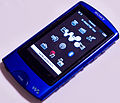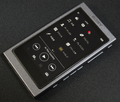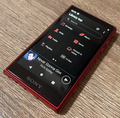Series
(NW*-) | Image | Model | Capacity | Release Date (may differ by region) | Display | OS | Rated battery life (hours) | Supported audio formats | FM radio | Data/power connection (input/output) | Physical size | Weight |
|---|
A3000 /
A1000 |  | NW-A1000 | 6 GB | November 19, 2005 [41] | 1.5" OLED (monochrome) | N/A | Audio: 16–20 | ATRAC, MP3, WMA, AAC(through update) |  N N | Multi Terminal (42 pin) / USB | 88.1 mm
55 mm
18.7 mm | 109 g
(3.9 oz) |
|---|
| NW-A1200 | 8 GB |
| NW-A3000 | 20 GB | 2.0" OLED (monochrome) | Audio: 28–35 | 104.2 mm
65.2 mm
21.4 mm | 182 g (6.5 oz) |
| First A Series Walkman, successor of NW-HD-5. Hard disk based. 6-band equaliser. [42] |
| A600 |  | NW-A605 | 512 MB | November 19, 2005 [41] | 3-line OLED monochrome | N/A | Audio: 45–50 | ATRAC, MP3, WMA |  Y Y | Mini-B USB / USB | 28.8 mm
84.9 mm
13.9 mm | 47 g
(1.66 oz) |
|---|
| NW-A607 | 1 GB |
| NW-A608 | 2 GB |
| Successor of the NW-E500. Flash based. The only A Series player in a non-bar form factor. |
| A800 |  | NW-A805 | 2 GB | March 21, 2007 [43] | 2" TFT LCD
240 x 320 (QVGA) | N/A | Audio: 27–30
Video: 7 | ATRAC, MP3, WMA, AAC |  N N | WM-PORT / USB | 88 mm
43.8 mm
9.1 mm | 53 g
(1.87 oz) |
|---|
| NW-A806 | 4 GB |
| NW-A808 | 8 GB |
| Colour display. Video-playing capability added. ATRAC Advanced Lossless support. DSEE and Clear Audio technologies added. [44] |
| A810 |  | NWZ-A815 | 2 GB | September 2007 | 2" TFT LCD
240 x 320 (QVGA) | N/A | Audio: 33
Video: 8 | MP3, WMA, AAC |  N N | WM-PORT / USB | 88 mm
44.5 mm
9.6 mm | 53 g
(1.87 oz) |
|---|
| NWZ-A816 | 4 GB |
| NWZ-A818 | 8 GB |
| Removal of ATRAC support. Works with Windows Media Player 11 instead of SonicStage. First video Walkman released in North America. Not released in Japan. |
A820 /
A720 /
A910 (Japan) |  | NWZ-A726 | 4 GB | March 20, 2008 [45] | 2.4" TFT LCD
240 x 320 (QVGA) | N/A | Audio: 36
Video: 10 | MP3, WMA, AAC, ATRAC (Japanese market) |  N N | WM-PORT / USB | 93.6 mm
50.2 mm
9.3 mm | 58 g
(2.05 oz) |
|---|
| NWZ-A728 | 8 GB |
| NWZ-A729 | 16 GB |
| NWZ-A826 | 4 GB |
| NWZ-A828 | 8 GB |
| NWZ-A829 | 16 GB |
| NW-A916 | 4 GB | November 17, 2007 [46] | Audio: 31–36
Video: 10–13 TV broadcast: 6-8 [47] | ATRAC, MP3, WMA, AAC | 86.8 mm
48.3 mm
12.3 mm | 74 g (2.81 oz) |
| NW-A918 | 8 GB |
| NW-A919 | 16 GB |
| Bluetooth functionality added (A820 only). A820 also adds noise cancelling over A720. A910 in Japan includes 1seg television tuner. |
| A840 |  | NWZ-A844 | 8 GB | October 31, 2009 [48] | 2.8" OLED
240 x 400 (WQVGA) | N/A | Audio: 29
Video: 9 | MP3, WMA, AAC, ATRAC (Japanese market) |  Y Y | WM-PORT / USB | 104.9 mm
46.8 mm
7.2 mm | 62 g
(2.19 oz) |
|---|
| NWZ-A845 | 16 GB |
| NWZ-A846 | 32 GB |
| NWZ-A847 | 64 GB |
| First A Series Walkman with S-Master Digital Amplifier technology (second Walkman after X Series). FM radio tuner added. |
| A850 (Japan) | | NW-A855 | 16 GB | November 13, 2010 [49] | 2.8" OLED
240 x 400 (WQVGA) | N/A | Audio: 19–29
Video: 9–11 | ATRAC, MP3, WMA, AAC |  Y Y | WM-PORT / USB | 104.9 mm
46.8 mm
7.2 mm | 62 g
(2.19 oz) |
|---|
| NW-A856 | 32 GB |
| NW-A857 | 64 GB |
| Same design as A840. |
| A860 |  | NWZ-A864 | 8 GB | October 8, 2011 [50] | 2.8" TFT LCD
240 x 400 (WQVGA) | N/A | Audio: 20–23
Video: 4–5 | MP3, WMA, AAC, ATRAC (Japanese market) |  Y Y | WM-PORT / USB | 96.9 mm
51.8 mm
9.3 mm | 77 g
(2.72 oz) |
|---|
| NWZ-A865 | 16 GB |
| NWZ-A866 | 32 GB |
| NWZ-A867 | 64 GB |
| Final A Series player before replacement by F Series. |
| A10 |  | NWZ-A15 | 16 GB | November 8, 2014 [51] | 2.2" TFT LCD
320 x 240 (QVGA) | N/A | Audio: 30–50
Video: | MP3, WMA, AAC, FLAC, ALAC, AIFF, ATRAC (Japanese market) |  Y Y | WM-PORT / USB | 110 mm
43 mm
8 mm | 66 g
(2.33 oz) |
|---|
| NW-A16 | 32 GB |
| NWZ-A17 | 64 GB |
| First model of revived A Series, successor of NWZ-F880. First A Series with NFC connectivity, Direct Stream Digital (DSD) technology added, support for FLAC and ALAC audio formats, and MicroSD slot. LDAC support (via update). |
| A20 | | NW-A25* | 16 GB | October 10, 2015 [52] | 2.2" TFT LCD
320 x 240 (QVGA) | N/A | Audio: 30–50
Video: 10–14 | MP3, WMA, AAC, FLAC, ALAC, AIFF, ATRAC (Japanese market) |  Y Y | WM-PORT / USB | 109 mm
43.6 mm
8.7 mm | 66 g
(2.33 oz) |
|---|
| NW-A26HN | 32 GB |
| NW-A27HN | 64 GB |
| Digital noise cancellation. Support for LDAC. |
| A30 |  | NW-A35* | 16 GB | October 29, 2016 [53] | 3.1" TFT LCD
800 x 480 (WVGA) | N/A | Audio: 22–45 | MP3, WMA, AAC, FLAC, ALAC, AIFF, DSD, ATRAC (Japanese market) |  Y Y | WM-PORT / USB | 97.5 mm
55.9 mm
10.9 mm | 98 g
(3.46 oz) |
|---|
| NW-A36HN | 32 GB |
| NW-A37HN | 64 GB |
| New touchscreen based design and operation. |
| A40 | | NW-A45* | 16 GB | October 7, 2017 [54] | 3.1" TFT LCD
800 x 480 (WVGA) | N/A | Audio: 30–50 | MP3, WMA, AAC, FLAC, ALAC, AIFF, DSD, APE, MQA, ATRAC (Japanese market) |  Y Y | WM-PORT / USB | 97.5 mm
55.9 mm
10.9 mm | 98 g
(3.46 oz) |
|---|
| NW-A46HN | 32 GB |
| NW-A47 | 64 GB |
| aptX and USB DAC support. |
| A50 |  | NW-A55* | 16 GB | October 6, 2018 [55] | 3.1" TFT LCD
800 x 480 (WVGA) | N/A | Audio: 30–50 | MP3, WMA, AAC, FLAC, ALAC, AIFF, DSD, APE, MQA, ATRAC (Japanese market) |  Y Y | WM-PORT / USB | 97.3 mm
55.7 mm
10.8 mm | 99 g
(3.5 oz) |
|---|
| NW-A56* | 32 GB |
| NW-A57* | 64 GB |
| More slim edges, FM radio on all models except NW-A55L. Functional Bluetooth beam. |
| A100 |  | NW-A100TPS | 16 GB | November 14, 2019 [56] | 3.6" TFT LCD
1280 x 720 (HD) | Android 9 | Audio: 8-26 | MP3, WMA, AAC, FLAC, ALAC, AIFF, DSD |  N N | USB-C / USB | 98.9 mm
55.9 mm
11 mm | 103 g
(3.64 oz) |
|---|
| NW-A105* | 16 GB | November 2, 2019 [56] |
| NW-A106* | 32 GB |
| NW-A107* | 64 GB |
| First A Series player running Android OS software. WM-PORT terminal replaced with USB Type C. No FM radio, SensMe, or Japanese ATRAC support. |
| A300 | | NW-A306 | 32 GB | January 27, 2023 (Japan) | 3.6" TFT LCD
1280 x 720 (HD) | Initially released with Android 12, can be updated to Android 13 and Android 14 [57] | Audio: 11–36 | MP3, WMA, AAC, FLAC, ALAC, AIFF, DSD |  N N | USB-C / USB | 98.4 mm
56.5 mm
11.8 mm | 113 g
(3.99 oz) |
|---|
| NW-A307 | 64 GB |
| New sleek design, USB DAC support, and DSEE Ultimate. No NFC and Noise Cancelling |


















